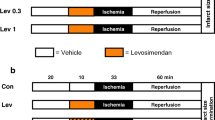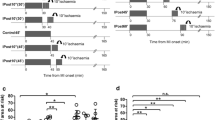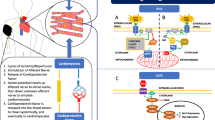Abstract
We investigated the effects of 5-(N-ethyl-N-isopropyl)amiloride (EIPA) on infarction in isolated rabbit hearts and cardiomyocytes. Thirty min of regional ischemia caused 29.6±2.8% of the risk zone to infarct in untreated Krebs buffer-perfused hearts. Treatment with EIPA (1 μM) for 20 min starting either 15 min before ischemia or 15 min after the onset of ischemia significantly reduced infarction to 5.4±2.0% and 7.0±1.0%, respectively (p<0.01 versus untreated hearts). In both cases salvage was very similar to that seen with ischemic preconditioning (PC) (7.1±1.5% infarction). Unlike the case with ischemic preconditioning, however, protection from EIPA was not blocked by 50μM polymyxin B, a PKC inhibitor, or 1μM glibenclamide, a KATP channel blocker. Forty-five min of regional ischemia caused 51.0±2.9% infarction in untreated hearts. Ischemic preconditioning reduced infarction to 23.4±3.1% (p<0.001 versus untreated hearts). In these hearts with longer periods of ischemia pretreatment with EIPA reduced infarction similarly to 28.8±2.1% (p<0.01 versus untreated hearts). However, when EIPA was combined with ischemic PC, no further reduction in infarction was seen (23.8±3.5% infarction). To further elucidate the mechanism of EIPA's cardioprotective effect, this agent was also examined in isolated rabbit cardiomyocytes. Preconditioning caused a delay of about 30 min in the progressive increase in osmotic fragility that occurs during simulated ischemia. In contrast, EIPA had no effect on the time course of ischemia-induced osmotic fragility. Furthermore, EIPA treatment did not alter the salutary effect of ischemic preconditioning when the two were combined in this model. We conclude that Na+/H+ exchange inhibition limits myocardial infarction in the isolated rabbit heart by a mechanism which is quite different from that of ischemic preconditioning. Despite the apparently divergent mechanisms, EIPA's cardioprotective effect could not be added to that of ischemic or metabolic preconditioning in these models.
Similar content being viewed by others
References
Armstrong S, Downey JM, Ganote CE (1994) Preconditioning of isolated rabbit cardiomyocytes: induction by metabolic stress and blockade by the adenosine antagonist SPT and calphostin C, a protein kinase C inhibitor. Cardiovasc Res 28: 72–77
Armstrong S, Ganote CE (1994) Adenosine receptor specificity in preconditioning of isolated rabbit cardiomyocytes: evidence of A3 receptor involvement. Cardiovasc Res 28: 1049–1056
Armstrong S, Ganote CE (1994) Preconditioning of isolated rabbit cardiomyocytes: effects of glycolytic blockade, phorbol esters, and ischaemia. Cardiovasc Res 28: 1700–1706
Armstrong SC, Hoover DB, DeLacey MH, Ganote CE (1996) Translocation of PKC, protein phosphatase inhibition and preconditioning of rabbit cardiomyocytes. J Mol Cell Cardiol 28: 1479–1492
Armstrong SC, Liu GS, Downey JM, Ganote CE (1995) Potassium channels and preconditioning of isolated rabbit cardiomyocytes: effects of glyburide and pinacidil. J Mol Cell Cardiol 27: 1765–1774
Auchampach JA, Maruyama M, Cavero I, Gross GJ (1992) Pharmacological evidence for a role of ATP-dependent potassium channels in myocardial stunning. Circulation 86: 311–319
Baines CP, Goto M, Downey JM (1997) Oxygen radicals released during ischemic preconditioning contribute to cardio-protection in the rabbit myocardium. J Mol Cell Cardiol 29: 207–216
Bugge E, Munch-Ellingsen J, Ytrehus K (1996) Reduced infarct size in the rabbit heartin vivo by ethylisopropyl-amiloride. A role for Na+/H+ exchange. Basic Res Cardiol 91: 203–209
Bugge E, Ytrehus K (1995) Inhibition of sodium-hydrogen exchange reduces infarct size in the isolated rat heart—a protective additive to ischaemic preconditioning. Cardiovasc Res 29: 269–274
Casnellie JE (1991) Protein kinase inhibitors: probes for the functions of protein phosphorylation. Adv Pharmacol 22: 167–205
Cohen MV, Downey JM (1996) Myocardial preconditioning promises to be a novel approach to the treatment of ischemic heart disease. Annu Rev Med 47: 21–29
Cole WC, McPherson CD, Sontag D (1991) ATP-regulated K+ channels protect the myocardium against ischemia/reperfusion damage. Circ Res 69: 571–581
du Toit EF, Opie LH (1993) Role for the Na+/H+ exchanger in reperfusion stunning in isolated perfused rat heart. J Cardiovasc Pharmacol 22: 877–883
Duan J, Karmazyn M (1992) Protective effects of amiloride on the ischemic reperfused rat heart. Relation to mitochondrial function. Eur J Pharmacol 210: 149–157
Frelin C, Vigne P, Lazdunski M (1984) The role of the Na+/H+ exchange system in cardiac cells in relation to the control of the internal Na+ concentration. J Biol Chem 259: 8880–8885
Ganote C, Armstrong S (1993) Ischaemia and the myocyte cytoskeleton: review and speculation. Cardiovasc Res 27: 1387–1403
Gold MR, Strichartz GR (1991) Use-dependent block of atrial sodium current by ethylisopropylamiloride. J Cardiovasc Pharmacol 17: 792–799
Goto M, Liu Y, Yang X-M, Ardell JL, Cohen MV, Downey JM (1995) Role of bradykinin in protection of ischemic preconditioning in rabbit hearts. Circ Res 77: 611–621
Gross GJ, Auchampach JA (1992) Blockade of ATP-sensitive potassium channels prevents myocardial preconditioning in dogs. Circ Res 70: 223–233
Hendrikx M, Mubagwa K, Verdonck F, Overloop K, Van Hecke P, Vanstapel F, Van Lommel A, Verbeken E, Lauweryns J, Flameng W (1994) New Na+−H+ exchange inhibitor HOE 694 improves postischemic function and high-energy phosphate resynthesis and reduces Ca2+ overload in isolated perfused rabbit heart. Circulation 89: 2787–2798
Jennings RB, Reimer KA (1981) Lethal myocardial ischemic injury. Am J Pathol 102: 241–255
Kaplan SH, Yang H, Gilliam DE, Shen J, Lemasters JJ, Cascio WE (1995) Hypercapnic acidosis and dimethyl amiloride reduce reperfusion induced cell death in ischaemic ventricular myocardium. Cardiovasc Res 29: 231–238
Karmazyn M (1988) Amiloride enhances postischemic ventricular recovery: possible role of Na+−H+ exchange. Am J Physiol 255: H606-H615
Karmazyn M, Moffat MP (1993) Role of Na+/H+ exchange in cardiac physiology and pathophysiology: mediation of myocardial reperfusion injury by the pH paradox. Cardiovasc Res 27: 915–924
Klein HH, Pich S, Bohle RM, Wollenweber J, Nebendahl K (1995) Myocardial protection by Na+−H+ exchange inhibition in ischemic, reperfused porcine hearts. Circulation 92: 912–917
Kleyman TR, Cragoe EJ Jr (1988) Amiloride and its analogs as tools in the study of ion transport. J Membrane Biol 105: 1–21
Lazdunski M, Frelin C, Vigne P (1985) The sodium/hydrogen exchange system in cardiac cells: its biochemical and pharmacological properties and its role in regulating internal concentrations of sodium and internal pH. J Mol Cell Cardiol 17: 1029–1042
Liu Y, Cohen MV, Downey JM (1994) Chelerythrine, a highly selective protein kinase C inhibitor, blocks the antiinfarct effect of ischemic preconditioning in rabbit hearts. Cardiovasc Drugs Ther 8: 881–882
Liu Y, Tsuchida A, Cohen MV, Downey JM (1995) Pretreatment with angiotensin II activates protein kinase C and limits myocardial infarction in isolated rabbit hearts. J Mol Cell Cardiol 27: 883–892
Meng H-P, Maddaford TG, Pierce GN (1993) Effect of amiloride and selected analogues on postischemic recovery of cardiac contractile function. Am J Physiol 264: H1831-H1835
Meng H-P, Pierce GN (1990) Protective effects of 5-(N,N-dimethyl) amiloride on ischemia-reperfusion injury in hearts. Am J Physiol 258: H1615-H1619
Miki T, Sato H, Cohen MV, Downey JM (1996) Opioid receptor contributes to ischemic preconditioning through protein kinase C activation in rabbits. Circulation 94 (Suppl I): I-392–I-393
Moffat MP, Karmazyn M (1993) Protective effects of the potent Na/H exchange inhibitor methylisobutyl amiloride against post-ischemic contractile dysfunction in rat and guinea-pig hearts. J Mol Cell Cardiol 25: 959–971
Munch-Ellingsen J, Bugge E, Ytrehus K (1996) Blockade of the KATP-channel by glibenclamide aggravates ischemic injury, and counteracts ischemic preconditioning. Basic Res Cardiol 91: 382–388
Murphy E, Perlman M, London RE, Steenbergen C (1991) Amiloride delays the ischemia-induced rise in cytosolic free calcium. Circ Res 68: 1250–1258
Murry CE, Jennings RB, Reimer KA (1986) Preconditioning with ischemia: a delay of lethal cell injury in ischemic myocardium. Circulation 74: 1124–1136
Myers ML, Mathur S, Li G-H, Karmazyn M (1995) Sodium-hydrogen exchange inhibitors improve postischaemic recovery of function in the perfused rabbit heart. Cardiovasc Res 29: 209–214
Otani H, Kato Y, Ko T, Sakurai Y, Kagawa K, Tanaka K, Fukunaka M, Imamura H, Cragoe EJ Jr (1991) Effects of amiloride and an analogue on ventricular arrhythmias, contracture and cellular injury during reperfusion in isolated and perfused guinea pig heart. Jap Circ J 55: 845–856
Pike MM, Luo CS, Clark MD, Kirk KA, Kitakaze M, Madden MC, Cragoe EJ Jr, Pohost GM (1993) NMR measurements of Na+ and cellular energy in ischemic rat heart: role of Na+−H+ exchange. Am J Physiol 265: H2017-H2026
Ramasamy R, Liu H, Anderson S, Lundmark J, Schaefer S (1995) Ischemic preconditioning stimulates sodium and proton transport in isolated rat hearts. J Clin Invest 96: 1464–1472
Scholz W, Albus U, Counillon L, Gögelein H, Lang H-J, Linz W, Weichert A, Schölkens BA (1995) Protective effects of HOE642, a selective sodium-hydrogen exchange subtype 1 inhibitor, on cardiac ischaemia and reperfusion. Cardiovasc Res 29: 260–268
Scholz W, Albus U, Linz W, Martorana P, Lang HJ, Schölkens BA (1992) Effects of Na+/H+ exchange inhibitors in cardiac ischemia. J Mol Cell Cardiol 24: 731–740
Schulz R, Rose J, Heusch G (1994) Involvement of activation of ATP-dependent potassium channels in ischemic preconditioning in swine. Am J Physiol 267: H1341-H1352
Silva PH, Dillon D, Van Wylen DGL (1995) Adenosine deaminase inhibition augments interstitial adenosine but does not attenuate myocardial infarction. Cardiovasc Res 29: 616–623
Slotki IN, Schwartz JH, Alexander EA (1990) Na+−H+ exchange is stimulated by protein kinase C activation in inner medullary collecting duct cells. Am J Physiol 259: F666-F671
Tani M, Neely JR (1989) Role of intracellular Na+ in Ca2+ overload and depressed recovery of ventricular function of reperfused ischemic rat hearts: possible involvement of H+−Na+ and Na+−Ca2+ exchange. Circ Res 65: 1045–1056
Thornton JD, Liu GS, Olsson RA, Downey JM (1992) Intravenous pretreatment with A1-selective adenosine analogues protects the heart against infarction. Circulation 85: 659–665
Tsuchida A, Liu Y, Liu GS, Cohen MV, Downey JM (1994) α-Adrenergic agonists precondition rabbit ischemic myocardium independent of adenosine by direct activation of protein kinase C. Circ Res 75: 576–585
Van Winkle DM, Chien GL, Wolff RA, Soifer BE, Kuzume K, Davis RF (1994) Cardioprotection provided by adenosine receptor activation is abolished by blockade of the KATP channel. Am J Physiol 266: H829-H839
Vaughan-Jones RD, Wu M-L (1990) Extracellular H+ inactivation of Na+−H+ exchange in the sheep cardiac purkinje fibre. J Physiol 428: 441–466
Walsh RS, Tsuchida A, Daly JJF, Thornton JD, Cohen MV, Downey JM (1994) Ketamine-xylazine anaesthesia permits a KATP channel antagonist to attenuate preconditioning in rabbit myocardium. Cardiovasc Res 28: 1337–1341
Wilde AAM, Janse MJ (1994) Electrophysiological effects of ATP sensitive potassium channel modulation: implications for arrhythmogenesis. Cardiovasc Res 28: 16–24
Yasutake M, Ibuki C, Hearse DJ, Avkiran M (1994) Na+/H+ exchange and reperfusion arrhythmias: protection by intracoronary infusion of a novel inhibitor. Am J Physiol 267: H2430-H2440
Ytrehus K, Liu Y, Tsuchida A, Miura T, Liu GS, Yang X-M, Herbert D, Cohen MV, Downey JM (1994) Rat and rabbit heart infarction: effects of anesthesia, perfusate, risk zone, and method of infarct sizing. Am J Physiol 267: H2383-H2390
Author information
Authors and Affiliations
Additional information
This study was supported in part by grants from the National Institute of Health Heart, Lung and Blood Institute, HL-20648 and HL-50688
Rights and permissions
About this article
Cite this article
Sato, H., Miki, T., Vallabhapurapu, R.P. et al. The mechanism of protection from 5 (N-ethyl-N-isopropyl)amiloride differs from that of ischemic preconditioning in rabbit heart. Basic Res Cardiol 92, 339–350 (1997). https://doi.org/10.1007/BF00788946
Received:
Revised:
Accepted:
Issue Date:
DOI: https://doi.org/10.1007/BF00788946




